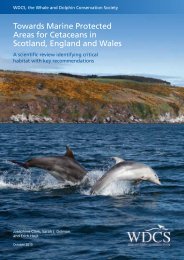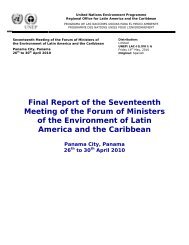Sea Turtle Recovery Action Plan for Barbados - WIDECAST
Sea Turtle Recovery Action Plan for Barbados - WIDECAST
Sea Turtle Recovery Action Plan for Barbados - WIDECAST
Create successful ePaper yourself
Turn your PDF publications into a flip-book with our unique Google optimized e-Paper software.
CEP Technical Report No. 12<br />
III. STRESSES ON SEA TURTLES IN BARBADOS<br />
3.1 Destruction or Modification of Habitat<br />
Beaches on the west and south coasts of <strong>Barbados</strong> are composed of coralline particles<br />
derived from the reefs offshore and are subject to seasonal erosion and accretion. Erosion<br />
generally occurs between January and March and accretion between April and September on<br />
west coast beaches; and erosion between March and September and accretion between October<br />
and February on south coast beaches. West coast beaches have diminished in size (presently<br />
they are about 15 m wide) at an average of 0.3 m/yr over the period 1954 to 1982. If this rate of<br />
erosion continues, some of these beaches may disappear by the year 2000. The south coast<br />
beaches, with a few notably bad exceptions, have remained fairly stable over this same period.<br />
Their stability may be due in part to the construction of groynes <strong>for</strong> sand entrapment. The east<br />
coast beaches have remained the most stable over this time period. The sand on these beaches is<br />
primarily siliceous and is derived from land-based sources, but they, too, are subject to erosion<br />
during the time when wave energy is at its highest on this coast (June-September). The erosion<br />
of beaches has serious implications <strong>for</strong> the future of tourism, and hence the economy of<br />
<strong>Barbados</strong>, apart from the effect on turtles nesting in <strong>Barbados</strong>.<br />
The loss of beaches has been attributed in part to natural phenomena such as the rising<br />
sea-level, but a more immediate correlation with disappearing beaches is the extensive beachfront<br />
development and accompanying loss of stabilizing beach vegetation that has occurred over<br />
the past few decades. <strong>Sea</strong>walls and boulders are often used to protect sea-front properties.<br />
These structures may aggravate beach erosion by deflecting wave energy abruptly downwards,<br />
thereby increasing the scouring effect of waves. The construction of hotels and houses continues<br />
on the few remaining undeveloped beach front areas on the west and south coasts. Hotels<br />
modify nesting areas more seriously than private houses. Ornamental and security lighting,<br />
removal of beach vegetation, and heavy pedestrian use of beaches may discourage turtles from<br />
nesting, as well as increase hatchling mortality and aggravate erosion. Specific measures<br />
designed to mitigate the degradation of nesting beaches are discussed in sections 4.13 and 4.6.<br />
As noted above, the lighting of beaches adjacent to houses and hotels may deter females<br />
from nesting (see also section 4.132). Moreover, several nesting females have been found on<br />
their backs in storm drains or wedged between boulders that have been placed to <strong>for</strong>tify the<br />
beach. There are now very few undeveloped beach front areas along the west and south coasts<br />
where females can emerge and nest in darkness. When nesting does occur adjacent to hotels and<br />
houses, hatchlings are invariably attracted to lights, and often not found until the next day or<br />
later. Mortality among disorientated hatchlings is high, and those that are found alive are often<br />
too exhausted to be released. Of 27 nests monitored in 1987-88, 14 (55.6%) were affected by<br />
beach lights at hatching, with up to 100% of hatchlings in affected nests orienting inland instead<br />
of toward the sea (section 4.132). In 1990, hatchlings from 83% of 35 monitored nests were<br />
disoriented by lighting. The problem may be worsening due to a generalized increase in security<br />
lighting.<br />
The health of the west and south coast fringing reefs in terms of coral cover and diversity<br />
and fish abundance and diversity is generally acknowledged to have deteriorated over the past 30<br />
Page 6

















